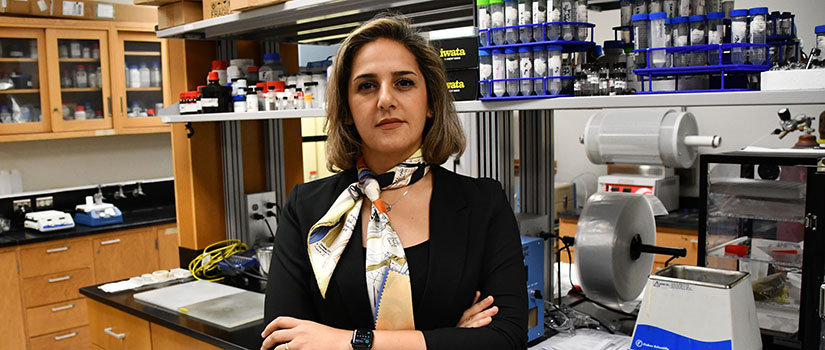At the recent Conference of the Parties to the United National Framework Convention on Climate Change, President Joe Biden reaffirmed the United States commitment to reducing carbon emissions by 50% by 2030. This requires replacing fossil fuels with renewable energy sources, which currently account for only 20% of all current energy uses.
Most renewable energy resources are scattered in time and place, but batteries will play an important role since they allow energy storage. Chemical Engineering Assistant Professor Golareh Jalilvand’s current research has been making headway in batteries expanding efficiency and potential.
Jalilvand’s lab focuses on improving the boundaries of lithium-ion batteries by exploring new chemistries and hierarchical structures of materials for next-generation batteries, such as lithium-sulfur. Batteries performance is based on the materials of both the cathode (positive) and anode (negative) electrodes. Jalilvand’s lab is currently testing sulfur’s possible use as the cathode. Sulfur is a promising choice for cathodes because it has a significantly higher ideal capacity than conventional cathode materials, more environmentally friendly, and inexpensive to acquire and use.
“One of the primary issues is that lithium-ion batteries don’t possess the energy or power density that is required for certain emerging applications, such as long-range electric vehicles and grid-level energy storage and delivery,” says Hunter McRay, an undergraduate researcher in Jalilvand’s lab. “Lithium-sulfur battery is a promising alternative for us because it has five times the theoretical energy density of a lithium-ion battery.”
But lithium-sulfur batteries suffer from challenges that have impeded their commercialization. Jalilvand’s team hopes to address those issues and unlock sulfur’s full battery potential.
“To pave the path to commercialization of lithium-sulfur batteries, this technology needs to be improved in two ways: achievable capacity and durability. So far, our team has had great success in addressing durability, and we are trying to improve achievable capacity as well.” Jalilvand says.
Jalilvand says that she knew her team was on to something promising, but unaware to the extent, when they reached over 500 cycles in their lithium-sulfur cells with high-capacity retention.
“I think what really made me realize the actual potential of our work was when we received tremendous interest from several industrial companies who were willing to invest in our research,” Jalilvand says. “A great sponsorship by NantG Powers was a result of this achievement, and since the start of our collaboration, not only have our lithium-sulfur batteries continued to show excellent cyclability for over 1,100 cycles, but their achievable capacity has improved by more than 50%.”
Jalilvand’s group had five presentations on their lithium-sulfur achievements, which all received positive feedback at this past October’s Electrochemical Society Conference. “This was the first time our data was publicly shared with the community, and we were excited by the feedback we received,” Jalilvand says.
The project’s goal is to reach a point where Jalilvand’s team will have a scalable and reliable lithium-sulfur battery. Her lab is currently working on plans that align with that goal, and barring any scientific and technical issues, they will produce the battery.
“Batteries are a big part of our daily life and something that you use and see daily. What I love about our research is that it is such a tangible and regularly used technology that I can actually talk about it with everyone, regardless of their technical knowledge,” Jalilvand says.
More efficient batteries are a growing field. For example, electric vehicles, satellites and aviation are areas that could benefit from a battery with a higher energy density. Batteries will continue to be a greener alternative to fossil fuels since they are rechargeable and do not produce extra exhaust.
“What I’m really happy about is that we have a great team of experts in our department and even across the university who do research on batteries,” Jalilvand says. “I believe we have a great opportunity to find a collaboratively driven battery research center which can make USC a great hub of battery research in the state of South Carolina.”
